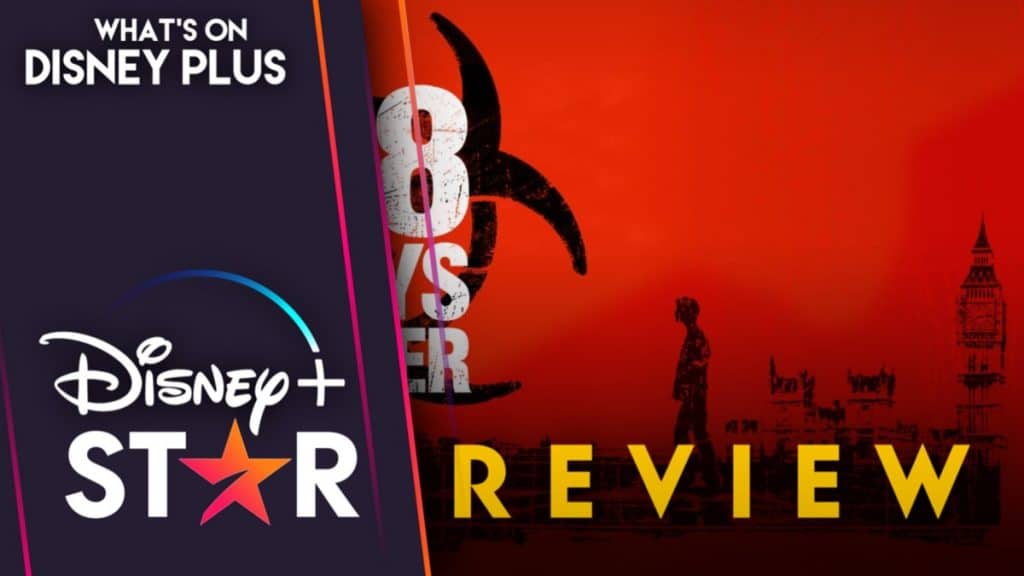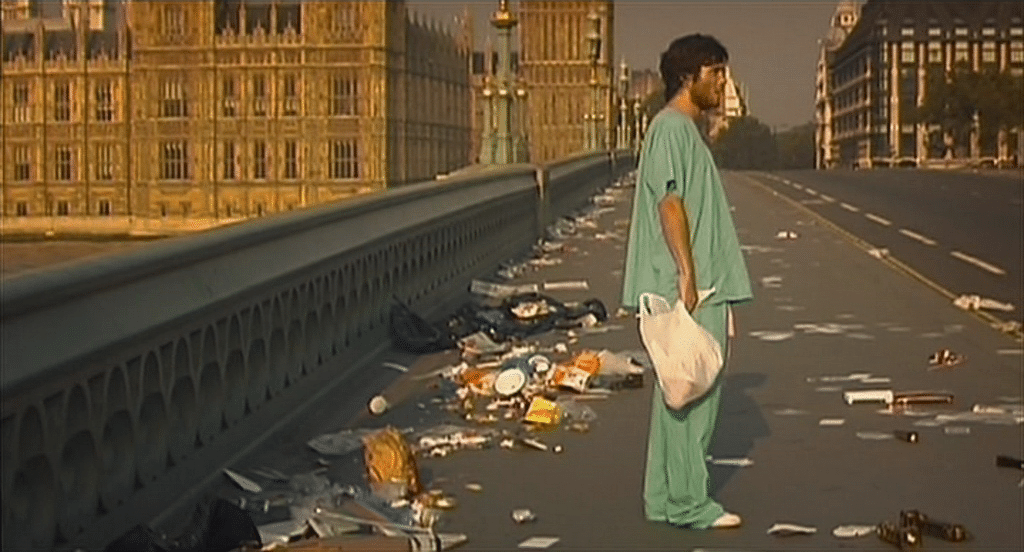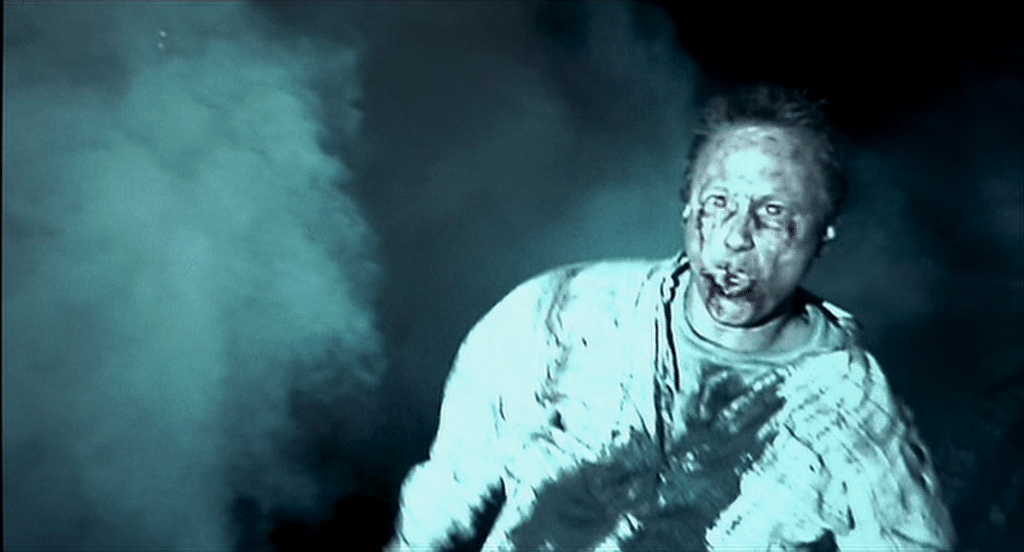
28 Days Later (2002) | Retro Star Review
In this classic apocalyptic horror, Jim (Cillian Murphy) awakens in hospital to find London seemingly deserted following a rapid viral outbreak. As he wanders, trying to come to terms with what has happened, he encounters other survivors. This includes Selena (Naomie Harris) and father and daughter Frank (Brendan Gleeson) and Hannah (Megan Burns). With no signs of a functioning society and the infected horde serving as a permanent looming threat, the makeshift group set their sights on the closest thing they have to a beacon of hope – a looped message promising sanctuary at a military compound…
It may be hard to remember now but there was a time back at the turn of the millennium before zombies had returned to (and then oversaturated) popular culture. When pinpointing the spark that lit the metaphorical fuse, many point to 28 Days Later for beginning the trend. The irony of this, is that by all the usual metrics, it isn’t a zombie picture. The infected are not dead. They don’t shuffle and groan. In fact, they shout and sprint. And yet, it did so much to revitalise and resurrect (hehe) a genre it was trying to avoid that the credit is undoubtedly deserved. So how did a small budget, British film distributed by Fox’s; “indie” label serve as a forebearer for a pop cultural zeitgeist? By being different. Allow me to explain.
While it’s true that we get a relatively brief prologue that’s rather intense to kick things off, I think what makes 28 Days stand out from the zombie fare from the past (or even much of what came after it) is that it feels no pressure to push the story along from A to B to C. Instead, it takes its time to introduce the world and the various main characters that inhabit it. And this world isn’t the stereotypical hellscape that you’d expect in a narrative where society has crumbled. Instead, there’s a looming melancholy to everything, a sadness. This isn’t about chaos for the vast majority of the running time. We watch people simply surviving and quietly mourning what they have lost. It’s harrowing and riveting to watch average British people trying to find a reason to live, to hope again. And finding hope is a key theme throughout.
But if we’re talking about people needing to find hope, I have to commend the performance of Cillian Murphy as Jim. As mentioned above, Jim awakens from a coma 28 days after a virus began tearing its way through the country. As a result, he works as a perfect proxy for the audience and the unsettling nature of the various scenes of pure desolation he is greeted with. Even if you’ve never seen the film before, there’s a decent chance that you’ve seen a clip or image of him wandering around a deserted London. This particular scene became instantly iconic and is still remembered for its striking imagery even now.
Murphy is outstanding throughout the film. He portrays trauma, the fledgling spark of hope in a man beginning to come to terms with the world as it now is and then furious rage as he sees that hope threatened. While that feels like quite the range for a single film, it’s surprisingly organic as we see him flourish as part of his little group (or family, if you prefer). Rather than feeling ponderous or even pretentious, the slower pace helps the core acting because it’s given the time to breathe and develop. So by the time Jim does partake in some frenzied action, we’re connected to him enough to care.
Speaking of caring, that brings us to Naomie Harris’ Selena. While it is rather obviously signposted that she is going to be Jim’s love interest, that doesn’t mean that she’s an uninteresting, two-dimensional character. Unlike Jim, she did see society crumble. It’s strongly alluded to that she’s both been betrayed and lost people she loved to the virus. As a result, Harris plays a guarded character very well. She’s tough and repeatedly shows that she’s willing to make the tough decisions. But still, there’s always an underlying integrity or “goodness” to her as a person. From a thematic point of view, it could be argued that she is the film’s answer to whether you can maintain your humanity when hope seems lost. Or at least, one of the answers. We’ll come back to that.
Brendan Gleeson and Megan Burns portray Frank and Hannah respectively. They are the only true family portrayed here as father and daughter. Their dynamic is particularly interesting to watch because it subtly changes over the course of the film. Initially, Hannah is quite subservient to her dad and makes sure to get his permission for any major decisions. However, she gradually gains confidence and begins to voice her own opinions. The best part of all of this is that their relationship is completely healthy. It’s simply a case of a girl becoming a more independent young woman. Both due to choice and narrative developments.
Now, as much as I’ve deservedly praised the main cast so far, there’s someone I’ve avoided discussing thus far and can do so no longer. I’m referring to Christopher Ecclestone’s Major Henry West. For lack of a better term, he is the film’s main protagonist. I said earlier that this film answers the question of maintaining your humanity after the end of the world in more than one way. West is the other side of that coin. And yet, the fact that Ecclestone is so charismatic and charming in the role makes the character he’s playing feel all the more nuanced and even perhaps sympathetic to some degree.
Finally, there is one more “character” that I have to mention. That is, of course, the infected. Despite having minimal dialogue and often appearing in multiples, they play a pivotal role in heightening the tension when it needs to ratchet up. And their ability to rapidly close long distances while screaming with fury the entire time makes them legitimately terrifying. They provide the peaks that holds the pacing together. Without them, the terrific acting and character development would fall flat.
Oh, and while we’re talking about elements that greatly enhance the film, the music score is incredible and still remembered fondly. Its suite rangers from sadder, calmer arrangements while characters are being contemplative to a well known, more adrenalised piece that accompanies the action scenes as they rapidly escalate. The music is exactly what it needs to be.
So, why did 28 Days Later become a huge success and help resurrect a genre? Because it wasn’t trying to be part of the genre it resurrected. It’s contemplative, yet able to be tense. The characters are relatable yet refuse to be pure stereotypes. It was the zombie film without zombies. It was the post-apocalyptic film that refused to play into the cliches. And that made it cool in its time. Now, 20 years later, it’s simply just a classic.
Rating: 5 stars out of 5
Disney Plus Presentation
28 Days Later is available on Disney+ in a maximum resolution of 1080p Full HD. This is in line with the physical releases worldwide.
28 Days Later does not currently include an “Extras” tab on its page as of writing, meaning that not even the standard “promo clip” is available.
Presentation Ranking: 4 stars out of 5
“28 Days Later” is available to stream on Disney+ now in many countries including the UK and Ireland, Canada, Australia and New Zealand, the Netherlands and more.
What are your thoughts on “28 Days Later”?




